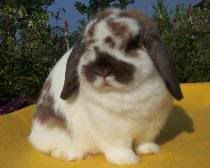Click to jump to a topic!
- Fur Problems
- Rabbit Fur Loss
Health Conditions and Concerns
There are myriad problems that can crop up with Holland fur. Fur mites can cause patches of fur to become missing at the rabbit scratches at irritated skin. You can see dandruff-looking flakes in the fur when this happens. Just as soon as I said that I had never had that problem, it cropped up in my barn. I treated it with Ivomectin given orally. (I am not a vet; you should consult your own veterinarian before planning any treatment of your rabbits.) Anyone who shows bunnies can get fur mites.
Ringworm can affect rabbits and cause a circular patch of missing fur. I suspected one bunny had this a couple of years ago (never confirmed) and I treated it with the same type of cream I would use on a human. (I’m still not a vet.
Sanitation is Important
Sanitation plays a huge part in Holland fur as well as their general health. Dirty cages will keep Holland feet stained. Although a certain amount of staining cannot be avoided (a Holland can make a mess in a cage in just one night), regular cage cleaning will keep the fur in much better condition. I feed large amounts of hay and allow my Hollands to pull through the hay rack whatever they want. If they lay down hay in their cages, fecal matter and urine will collect rapidly. It is important that I remove that excess hay daily to keep my Hollands healthy and looking good.
The location of your cages can affect your fur condition. My very first Holland buck was kept in a shed overhang with direct sunlight part of the day. His fur became so sunburned that the registrar thought my tort must be an orange. I now keep all of my bunnies out of direct sunlight. Reflected light can also be a problem, especially if you use metallic dividers in your cages. If your fur color is getting a washed-out look, evaluate the possibility that reflected light is causing the problem.
Correct Caging to Prevent Fur-Chewing

Neighbors can be problems. Boy, do I have stories to tell about my neighbors! But of course, I mean bunnies housed next to each other. If you’ve had Hollands for any length of time, you know that a Holland can spray at proportions previously only thought possible by super heroes. At Convention last year, I felt so sorry for a very light colored bunny who had an actively spraying buck right next door. The fur can be badly stained from neighbors spraying. Adding solid barriers can stop the staining from next door. However, it does increase the splash factor for the bunny to stain himself more.
The solid barrier does add protection, however, from barbering. I have a nice buck with a beautiful curvature on a flat little face who also loves to press that face against the wire for his neighbor to nibble. After having to let him grow that fur back in twice, I’ve moved him to one of my new cages that have double side walls with hay racks built between each cage. If the rack is full of hay, he is protected from spraying. But even empty, the space keeps him safe from any neighbors who might like to have a taste of his fur.
Of course even closer than a neighbor is a cage-mate, who has even more power to upset things. Cage space is always a problem in an active barn and you may have junior bunnies doubled or tripled. It is important to identify your most promising juniors and get them their own cages, if possible. Barbering and staining can be the least of the problems. It is always a shame to produce a great bunny only to have a chunk taken out of his ear.
Fur “Problems” that Aren’t Really Problems
 If your rabbit is suddenly losing lots of hair, it is not probably sick but more likely undergoing a normal molt. Hair can come out gradually, or in large clumps, even leaving bare places. Different rabbits have different molting patterns.
If your rabbit is suddenly losing lots of hair, it is not probably sick but more likely undergoing a normal molt. Hair can come out gradually, or in large clumps, even leaving bare places. Different rabbits have different molting patterns.
The last problem isn’t really a problem so much as the natural order of things. Does, that is female rabbits, that give birth will pull fur for their nests. Sometimes that fur-pulling is discrete and the doe may be shown in the not-too-distance future. Other times, she pulls huge clumps that take some time to grow back it. When a doe is going to be nursing a litter, it hardly matters. But for does that miss or for does that you plan to foster the litter for, it’s nice to have her in good shape to show in the meantime. Of course, there’s nothing to do except take what comes.

 Next Article: Special care of rabbits that are molting
Next Article: Special care of rabbits that are molting